Breast Asymmetry in Beverly Hills, CA
The Procedure
Breast asymmetry can include a unilateral large sagging breast on one side with a smaller tubular shape breast on the contralateral side. Other variations of breast asymmetry can include simply similar shape and size breasts without skin laxity or ptosis, but with different cup sizes. The most classic form, however, is a unilateral large sagging breast and a contralateral small tight tubular shape breast. This may be a congenital anomaly that has been notable since infancy with the child.
The procedure of reconstruction of breast asymmetry includes the use of breast lifts, breast reductions and breast implants.
Quality Candidates
- Women over the age of 18 years
- Women who feel physiologically and psychologically disturbed with the significant differences in the volume, size and shapes to their breasts
- Non Smoker – recommend to stop smoking at least two months prior to surgery
- Pre op recommendation of a mammogram if over 35 years of age
Profiles
The specific implants used depends upon the amount of breast tissue and the appearance the patient desires to achieve. Both saline and silicone implants can be used.
Low
Useful for women desiring less projection.
Least common
Moderate
Useful for women with thick chest walls.
High
Useful for patients with thin chest walls.
Most common
Extra High
Useful for patients who desire a larger implant.
Technique
| Inframammary | Periareolar | Transaxillary | Transumbilical | |
| Easy To Conceal | No | Yes | Yes | Yes |
| Effects Breast Feeding | <5-8% | 5-8% | <5% | <5% |
| Incision Point | Breast crease | Under areola | Armpit | Bellybutton |
| Recommended | Yes | Yes | No | No |
| Scarring | Yes | Yes | No | No |
Incision Types
Crescent Lift
Removing skin along the areolar
Benelli Lift
Known to be an unpredictable incision, may cause additional scarring.
Lollipop Lift
Allows tightening of the breast and repositioning of the nipple areolar complex.
Anchor (Wise-Pattern)
Useful for patients with severe ptosis, this is known as a formal mastopexy.
Anesthesia
Breast asymmetry procedures should be performed under general anesthesia with a Board Certified Anesthesiologist.
All anesthesia is performed by board certified anesthesiologist, Dr. Hoffman.
Laryngeal mask airways can be used in the majority of the patients. However, those who have a history of reflux or gastroesophageal disease are usually better candidates for endotracheal tube intubation. This should be discussed with your Board Certified Anesthesiologist.
Cost
Breast asymmetry cost will vary per patient.
This includes surgeon’s fee, operating room fees, implant cost and anesthesia fees.
Surgery Time Table
| Preoperative | Patient is started on an intravenous antibiotic (Ancef, Cipro and Vancomycin). |
| Surgery | A primary augmentation takes between 45 – 60 minutes. |
| Recovery Room | At least one hour. This is a requirement of federal law in Medicare. |
| After Surgery | Patients are sent home with a Bias wrap and gauze in place. No heavy lifting or raising the arm above the shoulder for three weeks. |
| Postoperative Visit | All dressings are removed.
An upper pole compression band is placed which allows the implant to maintain an inferior position and softening of the muscle so that there will only be natural occurrence over the next four to six weeks. Recommendation: The Linder Bra is a double clip zip mechanism, which allows easy placement with new gauze. It costs $49.95. |
| Day 7 Follow Up |
Breasts are examined for bleeding, infection, and positioning of the implants |
| Days 8 – 14 | Changing of the gauze will then occur twice a day for the next seven days.
Patients will do this at home. |
| Day 14 Follow Up |
The upper pole band may or may not be discarded, depending upon the placement of the implant at that time.
Sutures are removed. If there is any evidence of significant scabbing patients are asked to return in five days for final suture removal. |
| Days 14 – 21 | Light activities can resume.
Incisions can get wet while showering. |
Frequently Asked Questions
-
Is Dr. Linder Board Certified With The American Board Of Plastic Surgery?
Yes. There are absolutely no substitutes.
-
How Many Years Has Dr. Linder Been Performing Breast Enhancement Procedures?
Since 1997
-
Can I Expect My Breast To Be Even Once My Surgery Is Completed?
Absolute evenness of uniformity may not occur; however, more symmetry should occur and we do expect that the breast will be even in a bra, that the volume should look close enough to the eye that the patient does not feel asymmetric or hopeless.
-
Will My Nipples Have To Be Surgically Aligned?
Yes, the nipples will be surgically aligned by creating a breast asymmetry on the side where there is skin laxity and the nipple is below the fold.
-
At What Point Should A Young Woman Correct This?
We have operated on women as young as the age of 16 with the approval of the pediatrician due to severe disfigurement associated with physiological and psychological torment. Note: Recovery is a little different than primary augmentation, especially on the contralateral side where a reduction lift was performed. This can take up to 3-4 months for complete resolution of full edema and swelling. Sutures may stay in longer on this side than the primary augmentation contralateral side and this patient may require further scar treatments on this side, including Bio Corneum twice a day for up to one year.
-
In Which States Is Dr. Linder Licensed To Practice Surgery?
California and Nevada
-
Where Will The Surgery Be Performed?
Brighton Surgery Center – It is a Medicare Licensed Surgery Center in Beverly Hills, California.

